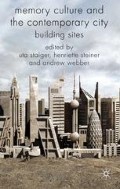Abstract
To write on memory and the city is to enter into a densely populated scholarly terrain. In the late twentieth century, engagement with memory became what Andreas Huyssen has called a ‘cultural obsession of monumental proportions’,1 and Jay Winter a ‘memory boom’,2 experienced both in academia and in popular culture. The 1990s, in particular, witnessed the rise of this ‘cult of memory’,3 as it turned into a veritable ‘memory industry’ able to play on and exploit the interest in memory. For some, however, this intensified interest has itself been interpreted as a sign of a memory crisis, and many scholars have advised about the concomitant terminological ambiguity, semantic burden and even rhetorical abuse which are also associated with this term.4 In fact, some have raised the question of whether and how in this situation a contemporary practice of ‘remembering well’ may be conceived at all.5 Overall, this epochal commitment to, and interrogation of, the past and its representation in the present can be described as a memory culture.
Access this chapter
Tax calculation will be finalised at checkout
Purchases are for personal use only
Preview
Unable to display preview. Download preview PDF.
Notes
A. Huyssen (2003), Present Pasts: Urban Palimpsests and the Politics of Memory (Stanford: Stanford University Press), p. 16.
J. Winter (2002), ‘The Generation of Memory: Reflections on the “Memory Boom” in Contemporary Historical Studies’, Bulletin of the German Historical Institute. 31. 69–92.
T. Todorov (2003), Hope and Memory: Lessons from the Twentieth Century, trans. David Bellos (Princeton: Princeton University Press).
See for example, K. L. Klein (2000), ‘On the Emergence of Memory in Historical Discourse’, Representations, 69, 127–50.
R. Sennett (1998), ‘Disturbing Memories’, in P. Fara and K. Patterson, eds, Memory (Cambridge: Cambridge University Press). p. 22.
See E. S. Casey (1987), Remembering — A Phenomenological Study (Bloomington: Indiana University Press).
J. Assmann (1999), Das kulturelle Gedächtnis: Schrift, Erinnerung und politische Identität in frühen Hochkulturen [Cultural Memory: Writing, Memory and Political Identity in the Early High Cultures] (Munich: C. H. Beck), p. 39 (editors’ translation).
A. Webber (2008), Berlin in the Twentieth Century — A Cultural Topography (Cambridge: Cambridge University Press), p. 14.
H. Bergson (1908), Matter and Memory, trans. N. M. Paul and W. S. Palmer (New York: Zone Books);
B. Russell (1921), The Analysis of Mind (London: Allen and Unwin).
See for example, M. Schechtmann (1996), The Constitution of Selves (Ithaca, NY: Cornell University Press).
W. Benjamin (2006), ‘On Some Motifs in Baudelaire’, in H. Eiland and M. W. Jenning, eds, Walter Benjamin: Selected Writings Volume 4, 1938–1940 (Cambridge, MA: Harvard University Press).
P. Ricoeur (2004), Memory, History, Forgetting (London, Chicago: The University of Chicago Press), p. 95.
M. Halbwachs (1950), The Collective Memory (New York: Harper-Colophon Books), p. 48.
See for example, P. Connerton (1989), How Societies Remember (Cambridge: Cambridge University Press).
See for example, N. M. Klein (1997), The History of Forgetting: Los Angeles and the Erasure of Memory (London: Verso Books).
C. Boyer (1996), The City of Collective Memory: Its Historical Imagery and Architectural Entertainments (Cambridge, MA: MIT Press).
P. Nora (1989), ‘Between Memory and History: Les Lieux de Mémoire’, Representations, 26, 7–24, p. 8.
K. L. Klein (1999), ‘On the Emergence of Memory in historical discourse’, p. 145. See also C. Maier (1993), ‘A Surfeit of Memory? Reflections on History, Melancholy and Denial’, History & Memory, 5, 136–51.
See for example, S. Friedländer (1993), Memory, History, and the Extermination of the Jews of Europe (Bloomington: Indiana University Press); D. LaCapra (1998), History and Memory After Auschwitz, (Ithaca, NY.: Cornell University Press).
Ibid. See also, among others, T. Todorov (2001), ‘The Uses and Abuses of Memory’, in H. Marchitello, ed., What Happens to History: The Renewal of Ethics in Contemporary Though (London: Routledge), pp. 11–22.
See for example L. Purbrick, J. Aulich, and G. Dawson, (2007), eds, Contested Spaces: Sites, Representations and Histories of Conflict (Basingstoke: Palgrave Macmillan).
W. V. J. Neill and H. U. Schwedler (2001), eds, Urban Planning and Cultural Inclusion: Lessons from Belfast and Berlin (Basingstoke: Palgrave Macmillan).
J. Winter (1995), Sites of Memory, Sites of Mourning: The Great War in European Cultural History (Cambridge: Cambridge University Press), p. 80.
J. E. Young (1993), The Texture of Memory. Holocaust Memorials and Meaning (New Haven, CT: Yale University Press), p. 30.
See also A. Huyssen (1999), ‘Monumental Seduction’, in M. Bal, ed., Acts of Memory: Cultural Recall in the Present (Hanover, NH: University Press of New England), pp. 191–207;
and P. Homans (2000), ed., Symbolic Loss: The Ambiguity of Mourning and Memory at Century’s End (Charlottesville: University Press of Virginia).
See particularly M. Crinson (2005), ‘Urban Memory — An Introduction’, in M. Crinson, ed., Urban Memory — History and Amnesia in the Modern City, (London New York: Routledge), pp. xi–xx.
E. Wilson and A. Webber (2008), Cities in Transition: The Moving Image and the Modern Metropolis (London: Wallflower Press).
Editor information
Editors and Affiliations
Copyright information
© 2009 Uta Staiger, Henriette Steiner and Andrew Webber
About this chapter
Cite this chapter
Staiger, U., Steiner, H. (2009). Introduction. In: Staiger, U., Steiner, H., Webber, A. (eds) Memory Culture and the Contemporary City. Palgrave Macmillan, London. https://doi.org/10.1057/9780230246959_1
Download citation
DOI: https://doi.org/10.1057/9780230246959_1
Publisher Name: Palgrave Macmillan, London
Print ISBN: 978-1-349-36655-2
Online ISBN: 978-0-230-24695-9
eBook Packages: Palgrave Social & Cultural Studies CollectionSocial Sciences (R0)

